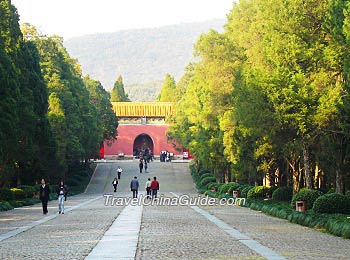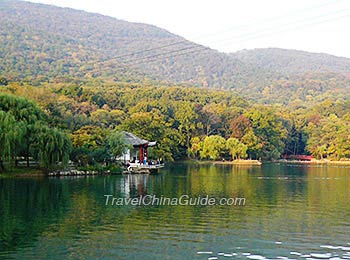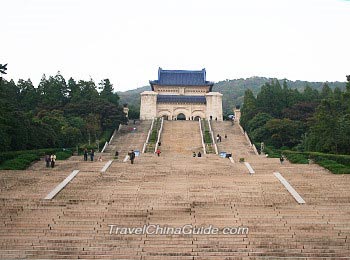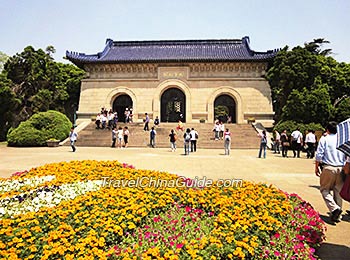Purple Mountain (Zhongshan Mountain National Park)
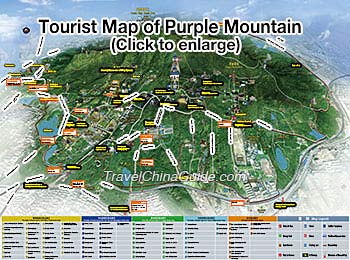 |
| Tourist Map of Purple Mountain (Click to enlarge) |
Towering in the eastern suburb of Nanjing, Purple Mountain (Zhongshan Mountain National Park) has been known as one of the four most famous mountains in Southern China. It got its name because purple clouds can often be seen at the top of the mountain. The mountain is not only very beautiful, but also rich in historical and cultural relics.
The mountain covers a total area of 31 square kilometers (12 square miles), with more than two hundred scenic spots, including fifteen key historical and cultural relics under state protection and one world cultural heritage site, the Xiaoling Mausoleum of Ming Dynasty. The Purple Mountain consists of four core scenic areas, including the Dr. Sun Yat-sen's Mausoleum Scenic Area on the southern slope, the Xiaoling Mausoleum of Ming Dynasty Scenic Area to the west of the Dr. Sun Yat-sen's Mausoleum and the Linggu Temple Scenic Area to the east, and the Toutuo Ridge Scenic Area on the mountain top.
The Xiaoling Mausoleum of Ming Dynasty is the largest imperial mausoleum in Nanjing. It was constructed in 1381. Emperor Zhu Yuanzhang, the first Emperor of the Ming Dynasty (1368- 1911), and his empress were buried in it in 1398. The magnificent mausoleum represents the highest level of architecture and stone carving art in the early Ming Dynasty. Renowned as "The First Imperial Mausoleum in the Ming and Qing Dynasties", the Xiaoling Mausoleum of Ming Dynasty has a dramatic influence on the pattern of imperial mausoleums in the following five hundred years. In July, 2003, the Xiaoling Mausoleum of Ming Dynasty was listed as a World Cultural Heritage Site by UNESCO.
|
|
Dr. Sun Yat-sen's Mausoleum is the burial site of Dr. Sun Yat-sen, the great pioneer of China's democratic revolution and "Father of the Republic of China". The mausoleum was constructed in three years from 1926 to 1929. It was listed as a key historical and cultural site under state protection in 1961 and a national AAAAA scenic spot in 2007.
On the archway is engraved "Universal Love" which is handwritten by Dr. Sun Yat-sen. Behind the archway is a path which is more than 480 meters (1,575 feet) and leads to the single-eave granite Mausoleum Gate. The gate is embellished with blue glazed tiles, with a length of 27 meters (86 feet), a width of 8.8 meters (29 feet) and a height of 16.5 meters (54 feet). It consists of three arched doors. On the door in the middle is carved the inscription "The Whole World as a Community" which is also written by Dr. Sun Yat-sen. Passing through a square Stele Pavilion, one will arrive at the Sacrificial Hall. The hall is made of white granite, concrete and steel, and decorated with blue glazed tiles. In the center of the hall stands a white marble sculpture of sitting Dr. Sun Yat-sen. Getting through the gate to the tomb, one will reach the coffin chamber. A white marble sculpture of lying Dr. Sun Yat-sen is located in the center. That is very solemn and respectful.
Apart from the mausoleum in Zhongshan Mountain National Park, there are also plenty of memorial buildings, including the Open-Air Music Hall, the Xingjian Pavilion, the Guanghua Pavilion, the Liuhui Waterside Pavilion, and the Sutra Depository. All the buildings are harmonious in color and structure. The Dr. Sun Yat-sen's Mausoleum is not only splendid, but also exquisite. Thus, it is renowned as the "First Mausoleum in the Architectural History of Modern China".
|
|
The Open-Air Music Hall is located in the southeast of the Dr. Sun Yat-sen's Mausoleum Square. With a gross area of 4,200 square meters (1 acre), the hall was built in about one year from 1932 to 1933. As a subordinate project of the Dr. Sun Yat-sen's Mausoleum, the Open-Air Music Hall is a place where musical performances and public speeches are held.
The semicircular hall is made of concrete and steel. At the center of the hall is the stage. Behind the stage stands an echo wall. In front of the stage is a banana-shaped lotus pond. A semicircular lawn in front of pond can hold three thousand people. Tourists can also take a rest in the corridor surrounding the lawn. Moreover, they can buy some foodstuff for the lovely white pigeons in the hall.
The roof is decorated with green glazed tiles and carved with more than 1,000 phoenixes. The yellow walls, red pillars, and beautiful paintings under the eave look very spectacular. In front of the building is a Buick car which was presented to Soong May-ling by the American government.
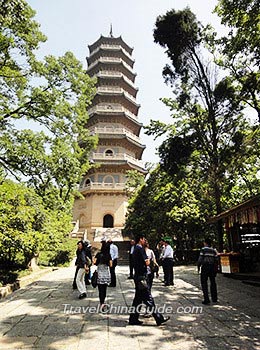 |
| Linggu Pagoda |
Built in the Southern Dynasties (420- 589), the Linggu Temple was first named "Kaishan Temple" in memory of the eminent monk Baozhi. Emperor Taizu in the Ming Dynasty presented the name "Linggu Temple" to it and bestowed the title "No. 1 Buddhist Temple under Heaven" upon it. In 1983, the temple was listed as a national key Buddhist temple in the Han nationality region.
Toutuo Ridge Scenic Area
Transportation
| Scenic Sites | By Metro (Closest Station) | By Bus (Closest Stop) |
|---|---|---|
| Xiaoling Mausoleum of Ming Dynasty | Line 2 (Muxuyuan Station), or Line 4 (Gangzicun Station) | Line 20, 315 or G5 (Xiaoling Mausoleum of Ming Dynasty Station) |
| Dr. Sun Yat-sen's Mausoleum | Line 2 (Xiamafang Station) | Line 34 (Dr. Sun Yat-sen's Mausoleum Parking Lot Station) |
| Linggu Temple | Line 2 (Zhonglingjie Station) | Line 202 (Linggusi Park) |
| Toutuo Ridge Scenic Area | Line 4 (Jiangwangmiao Station) | Line 20 or 315 (Purple Mountain Cableway Station) |
There are 8 sightseeing lines and 1 special line in the scenic area. They can take tourists from one scenic spot to another. The sightseeing line costs CNY 10 for a single trip, while the special line costs CNY 2 for a single trip.
| Bus Lines | Routes |
|---|---|
| Sightseeing Line 1 | Muxuyuan Metro Station- Square City- Meiling Palace (Ming Xiaoling Museum)- Underwater World- South Station of Dr. Sun Yat-sen's Mausoleum |
| Sightseeing Line 2 | Dr. Sun Yat-sen's Mausoleum Parking Lot (Zilanli Commercial Street)- South Station of Dr. Sun Yat-sen's Mausoleum- Xiaoling Mausoleum of Ming Dynasty (Zixia Lake) |
| Sightseeing Line 3 | Dr. Sun Yat-sen's Mausoleum- Xiaoling Mausoleum of Ming Dynasty (Zixia Lake) |
| Sightseeing Line 4 | East Station of Dr. Sun Yat-sen's Mausoleum- Linggu Scenic Area |
| Sightseeing Line 5 | Linggu Scenic Area- South Station of Dr. Sun Yat-sen's Mausoleum- Xiaoling Mausoleum of Ming Dynasty (Zixia Lake) |
| Sightseeing Line 6 | Dr. Sun Yat-sen's Mausoleum Parking Lot (Zilanli Commercial Street)- Meiling Palace (Ming Xiaoling Museum)- Underwater World- Xiaoling Mausoleum of Ming Dynasty (Zixia Lake) |
| Sightseeing Line 7 | Dr. Sun Yat-sen's Mausoleum- Xiamafang Metro Station |
| Sightseeing Circle Line | Muxuyuan Metro Station- Meiling Palace (Ming Xiaoling Museum)- Dr. Sun Yat-sen's Mausoleum Parking Lot - Linggu Scenic Area- South Station of Dr. Sun Yat-sen's Mausoleum- Xiaoling Mausoleum of Ming Dynasty- Underwater World- Meiling Palace- Muxuyuan Metro Station |
| Special Line 1 | Muxuyuan Metro Station- Xiamafang Metro Station- Dr. Sun Yat-sen's Mausoleum Parking Lot (Zilanli Commercial Street)- Meiling Palace (Ming Xiaoling Museum)- Underwater World- West Station of Dr. Sun Yat-sen's Mausoleum- Xiaoling Mausoleum of Ming Dynasty (Zixia Lake)- Meiling Palace (Ming Xiaoling Museum)- City Square- Muxuyuan Metro Station |
Admission Fee and Opening Hours
| Scenic Spots | Ticket Price | Opening Hours |
|---|---|---|
| Xiaoling Mausoleum of Ming Dynasty Scenic Area | CNY 70, including the Plum Blossom Hill | Mar. - Nov.: 6:30- 18:30 Dec. - Feb. next year: 7:00- 17:30 Ming Xiaoling Museum: 9:00 - 17:00 |
| Dr. Sun Yat-sen's Mausoleum Scenic Area | Free of charge | 8:30- 17:00, closed on Monday except during holidays. |
| Open-Air Music Hall | CNY 10 | Mar. - Nov.: 6:30- 18:30 Dec. - Feb. next year: 7:00- 17:30 |
| Meiling Palace | CNY 30 | 7:30 - 18:00 |
| Linggu Scenic Area | CNY 35 | Mar. - Nov.: 6:30- 18:00 Dec. - Feb. next year: 7:00- 17:30 |
| Toutuo Ridge Scenic Area | Free of charge | All day long |
Combo Ticket of the Attractions Mentioned Above | CNY 100 | --- |
Free for children under 1.4m (4.6 feet).
Recommended Nearby Attractions
2. Xuanwu Lake
3. City Wall
